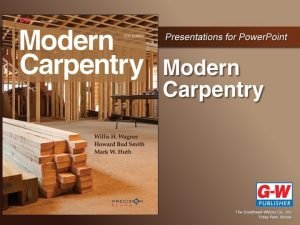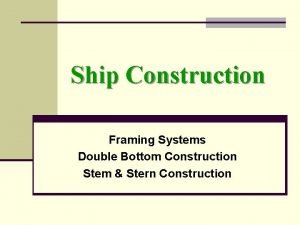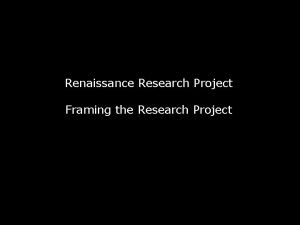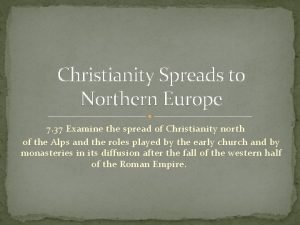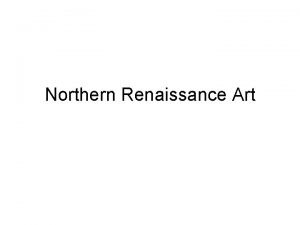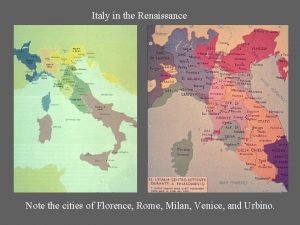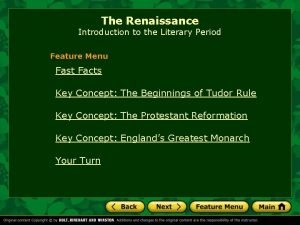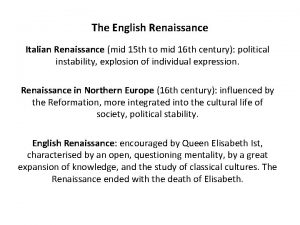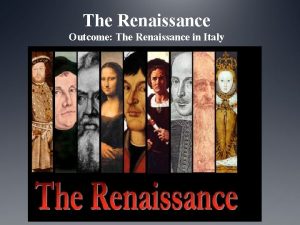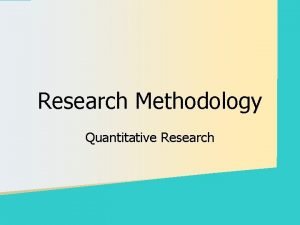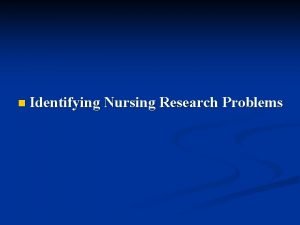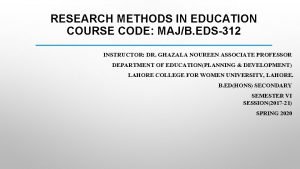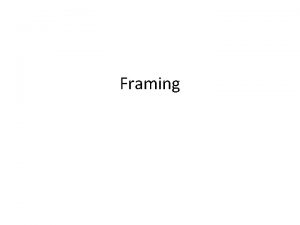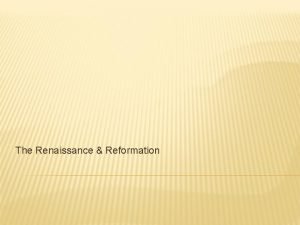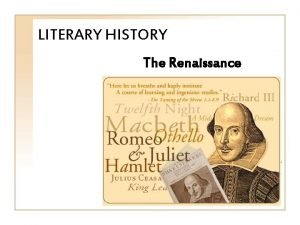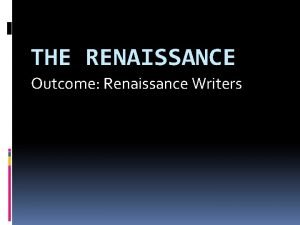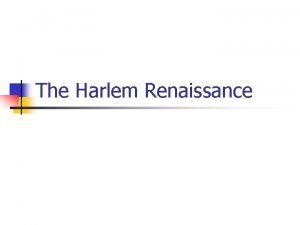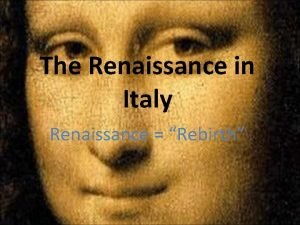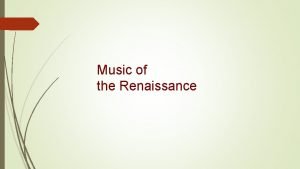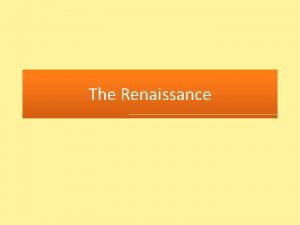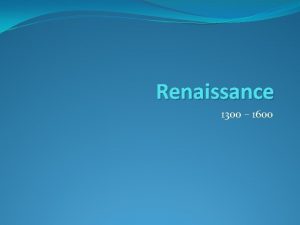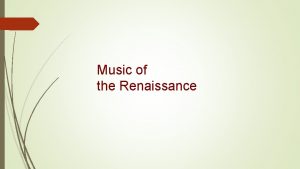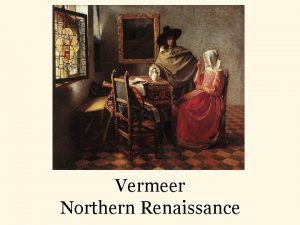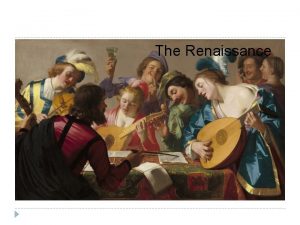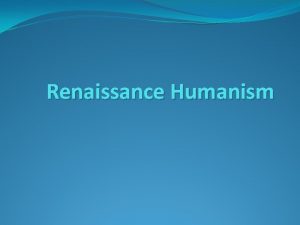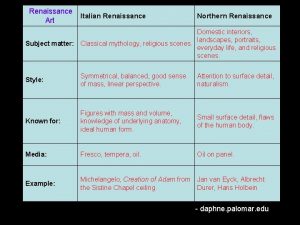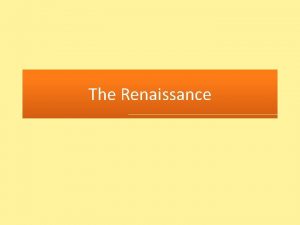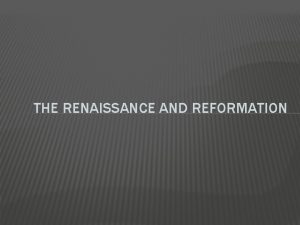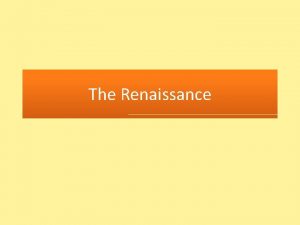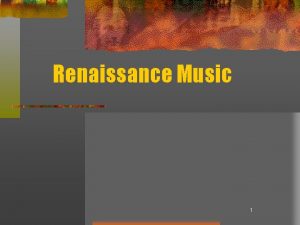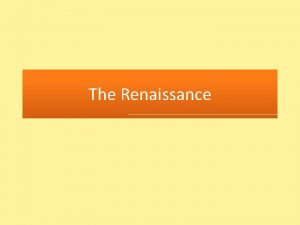Renaissance Research Project Framing the Research Project SOURCES



























- Slides: 27

Renaissance Research Project Framing the Research Project

SOURCES 2017 NICCOLÒ MACHIAVELLI, CLIZIA LUCREZIA MARINELLA, THE NOBILITY AND EXCELLENCE OF WOMEN AND THE DEFECTS AND VICES OF MEN BERNARDO DOVIZI DE BIBBIENA, THE COMEDY OF CALANDRO BOTTICELLI BRUCE PENMAN, ED. , FIVE RENAISSANCE COMEDIES ANTONIO MANETTI, THE FAT WOODCARVER

Coluccio Salutati, Selected Writings English State Papers from the Vatican Torquato Tasso, Aminta Female patrons of art Trials from Cohen and Cohen, Words and Deeds in Renaissance Rome

Renaissance maps Cecilia Ferrazzi, Autobiography of an Aspiring Saint Leonardo da Vinci’s notebooks Leon Battista Alberti, Momus

The aim of the Research Project is to shift your attention to primary sources and allow you to seriously engage with them, in preparation for more extensive research as in your final year dissertation.

NB The key question you are trying to answer with the project: How can we use this source (or these sources) to illuminate Renaissance History?

The source should drive the content of the project. (In this sense, this is different from what you are asked to do in a normal research essay) E. H. Carr, What is History?

Having chosen the source, read or examine it carefully, BEFORE you do too much secondary reading. Go back and read/examine it again after you have read more about its context.

Your close examination of the source should help you determine which issues you think are most important to focus on in the project; which aspects of Italian Renaissance life it tells us most about.

The Project should include discussion of: what kind of source is it? Its form, author, purpose, language, audience, context.

Title What is the correct and full title of the source?

Author Who produced the source? Who were they?

Patron Was there a patron? If so, who were they? NB Remember the contemporary view of the patron as the creator.

Date When was the source produced? Is the date significant? Why?

Form What form does the source take? E. g. letter, legal document, treatise, dialogue, play, poem, (auto)biography, history, chronicle, diary, painting, sculpture, building, etc. Why was that form chosen? How does the form affect the way the views are expressed by the author/artist?

Language If you are analysing a text, in which language was it written originally? Why was that language chosen?

Audience To whom is the source addressed? How do we know the audience? Who were the audience? Why does the author/artist/patron address that audience? Is the way the source is produced influenced by whom it is addressed to? How? Why?

Reference to event or situation Does the source refer or react to a particular event or situation? If so, discuss the context and nature of the event or situation in detail. What is the attitude of the author/artist/patron to the event or situation? Why does the author/artist/patron take that attitude?

Reference to people Does the source refer to a particular person or group of people? If so, discuss that person or group of people in detail. What is the attitude of the author/artist/patron to that person or group of people? Why does the author/artist/patron take that attitude?

Reference to text Does the source refer to a particular text? If so, discuss that text in detail. What is the attitude of the author/artist/patron to that text? Why does the author/artist/patron take that attitude?

Reference to existing belief, idea or practice Does the source refer or react to an existing belief, idea or practice? If so, discuss the context and nature of the belief, idea or practice in detail. What is the attitude of the author/artist/patron to the belief, idea or practice? Does the author/artist/patron support it or challenge it? How? Why?

Expression of new belief or idea Does the source express a new belief or idea? If so, discuss the belief or idea in detail. How is the belief or idea new? How did the author arrive at the new belief or idea? Why does the author express it now?

Diction If you are analyzing a text, how does the choice of words reflect the author’s attitude?

If you are analysing a visual source, check the questions about design, setting, symbols, and colour in the Visual Sources powerpoint.

Issues and Values What does the source tell us about social/religious/political issues and values such as gender, marriage, sexuality, morality, social status, justice, honour, family? What does the source tell us about cultural issues and values such as the revival of antiquity, humanism, the use of the vernacular? NB If you are using several sources, do they reveal changes over time or do some things continue? What are the reasons for this? What is the significance?

NB If you are analysing several sources, don’t write about each source in turn. Instead, you should identify themes and base your analysis on these themes.

Next week you will give a short presentation (5 -7 minutes) on your project and receive feedback from your tutor and seminar peers. The presentation workshops will be held from 10. 00 to 2. 00 in B 2. 02 (10 -12) and H 1. 48 (12 -2. 00). The deadline for the 4, 500 -word essay is 12 noon on 3 May. For details of submission, see http: //www 2. warwick. ac. uk/fac/arts/history/students/es saysubmission
 Framing system of the ship
Framing system of the ship Balloon framing vs platform framing
Balloon framing vs platform framing Web frames ship
Web frames ship Print and web sources
Print and web sources Important water resources
Important water resources Renaissance research project
Renaissance research project Cosimo de' medici
Cosimo de' medici Italian renaissance vs northern renaissance venn diagram
Italian renaissance vs northern renaissance venn diagram The renaissance outcome renaissance painters/sculptors
The renaissance outcome renaissance painters/sculptors Italian vs northern renaissance art
Italian vs northern renaissance art Renaissance vs high renaissance
Renaissance vs high renaissance The renaissance introduction to the renaissance answer key
The renaissance introduction to the renaissance answer key Italian renaissance vs english renaissance
Italian renaissance vs english renaissance The renaissance outcome the renaissance in italy
The renaissance outcome the renaissance in italy Framing a research question
Framing a research question Sources of research problem
Sources of research problem Sources of research problem
Sources of research problem How a research problem is formulated
How a research problem is formulated Nursing research problem statement examples
Nursing research problem statement examples Sources of research problem
Sources of research problem Hát kết hợp bộ gõ cơ thể
Hát kết hợp bộ gõ cơ thể Bổ thể
Bổ thể Tỉ lệ cơ thể trẻ em
Tỉ lệ cơ thể trẻ em Gấu đi như thế nào
Gấu đi như thế nào Tư thế worm breton là gì
Tư thế worm breton là gì Chúa yêu trần thế
Chúa yêu trần thế Các môn thể thao bắt đầu bằng từ đua
Các môn thể thao bắt đầu bằng từ đua

